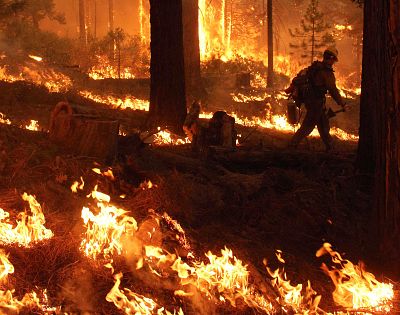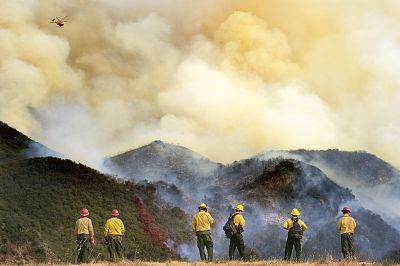"If you don't do the hiring on time, then you can't do the training on time, then you are not ready for the next fire season," a nonprofit leader said.
Controlled burns have been put on hold. Fire training sessions have been canceled. The hiring of hundreds of seasonal firefighters has been delayed.
The nation's wildland fire service — trying to regroup this winter after two of the biggest and deadliest fire seasons on record — has instead been cast into a state of anxiety by the three-week-old partial government shutdown. That's because some firefighters with the Forest Service, National Park Service and Bureau of Land Management are among the approximately 800,000 government employees either furloughed or working without a guarantee of pay.
The shutdown has affected hundreds of regular fire and support personnel at those agencies, along with seasonal "hotshots" and others who swell the fire lines during the forest and brush fire emergencies that have swept through the West with increasing intensity nearly every summer and fall, according to wildfire experts. A Senate Appropriations Committee report estimates that as many as 5,000 Forest Service firefighters may be working without pay.
Analysts say the sidelining of some firefighters comes at a difficult time because of the increasing length and arduousness of the fire calendar. After battling what was then the largest fire in California history in 2017, the Thomas Fire, and the deadliest fire in California history in November, the Camp Fire, firefighters do not appreciate going untrained and unpaid.
"Folks in the fire and land management agencies place a high value on the mission," said Jim Whittington, a more than 20-year employee with the Forest Service, Park Service and Bureau of Land Management, who became a consultant in 2017. "They signed up and are passionate about public lands, public safety and doing the right thing. To them, this shutdown is a real kick in the pants."
Some furloughed employees see an additional irony because the shutdown has delayed fire mitigation and training at a time when President Donald Trump has attacked California for poor forest management. But Whittington said most of his former co-workers are determined not to get involved in politics.
"We have seen three or four tweets on wildland fires and all of them have been met with raised eyebrows and some sense of disbelief in the wildland fire community," Whittington said of Trump's Twitter posts. "But we have lots of Republicans and lots of Democrats in our world. We have hippies and cowboys and hunters and poets. When we come together, we don't care about any of that political stuff. We are all working together on whatever incident we are on."
Regional forest officials in the West either did not answer their phones this week or referred calls to the service's parent agency in Washington, the U.S. Department of Agriculture. A spokeswoman there said an official shutdown plan has been put in place, ensuring that workers "essential to protect life and property" remain on duty.
"Preparing fire responders for the nation's 2019 fire suppression is part of the Forest Service shutdown plan," Katie O'Connor, a Forest Service spokeswoman, said in a statement. "The agency is committed to supporting activities such as temporary and permanent fire hiring ... and some essential trainings that are critical to 2019 fire suppression. These activities are prioritized because if the agency does not proceed we will jeopardize invested resources and risk not having permanent or temporary fire personnel on board and qualified to complete work later in the year."
The Forest Service does not have an "accurate number" of employees put on furlough, O'Connor said. But those who work closely with federal fire officials said that damage already is being done.
Controlled and so-called pile burns to rid the forests of flammable underbrush and debris have been put on hold since the government shut down. These fires either burn debris and small trees in prescribed areas or burn heaps of wood chips, pine cones and branches collected by forest workers during the summer.
One planned burn on private land in southwest Colorado that had been set for late December was called off because federal workers could not attend to assist, said Danny Margoles, coordinator for the Dolores Watershed Resilient Forest Collaborative, which brings together government, industry and conservation groups. The burn will be rescheduled, Margoles said.
A proposal to thin trees and burn brush in California's Stanislaus National Forest also may not happen, because Tuolumne County and Yosemite Stanislaus Solutions, a group of forest stakeholders, couldn't get needed information from the Forest Service to complete a grant application, said John Buckley, executive director of an environmental group in the state who is part of the leadership team with Yosemite.
The Forest Service's 10-page shutdown contingency plan allows completion of prescribed burns already underway but says there should be no new prescribed burns until the government reopens.
More fire mitigation work needs to be done in national forests, not less, said Buckley, adding: "And now, in 2019, less work is likely to be done unless this is resolved quickly."
Nick Goulette, executive director of the Watershed Center, a forestry nonprofit in California, said that there is a backlog of tens of thousands of piles of forest debris that need to be burned in the state. But there were too few workers to get the job done, even before the shutdown, he said.
"The U.S. Bureau of Land Management, National Park Service and National Forest Service essentially don't have their personnel on the ground," Goulette said. "And so they are not doing the mitigation work they typically do this time of year."
With federal employees off the job, training programs like a wildland fire workshop set for Missoula, Montana, in late January have been canceled, said Bill Gabbert, a longtime firefighter who now runs a blogabout wildfires.
The winter is normally a time for numerous other training sessions, from basic safety courses, which every firefighter must repeat annually, to sophisticated tactical simulations. Federal employees either manage or participate in many of those sessions, which now have been cast into doubt, several fire professionals said.
The Forest Service memo allows "critical fire training academies currently in session to prepare fire responders for the nation's 2019 fire suppression and emergency response needs." It does not make clear if trainings not already begun can remain on the calendar.
Although the Forest Service statement said critical hiring would go on unabated, one federal employee and an online posting suggested that a hiring event this week in South Dakota was put off because of the shutdown. The Forest Service's Region 2 "fire hire," covering Colorado, South Dakota, Nebraska, Kansas and most of Wyoming, was delayed, according to information posted on Facebook by the U.S. Hotshots Association, a group that represents seasonal firefighters.
New firefighters must pass a drug test and a physical, in addition to training, before they can be hired. Any slowdown in the hiring process "is a little scary because it could limit who is available," said one Forest Service employee, who declined to be named because she was not authorized to speak on the issue.
"If you don't do the hiring on time, then you can't do the training on time, then you are not ready for the next fire season," said Goulette of the Watershed Center, which is based in the Northern California town of Hayfork. "And with fire season expanding in California and across the West, you better be ready. Spring does not last as long as it used to."
Fire experts and climate scientists say warmer and drier weather has prolonged recent fire seasons, making winter recovery time even more precious for firefighters to regroup. "There can be a little over 300 days a year now that someone is fighting a fire somewhere," said Whittington, "compared to 200 or 250 days in the past. So the time to get over the last fire year and prepare for the next one is incredibly short."
The new attention comes at a time when wildfires have pushed to the forefront of the public's consciousness after 2017 wildfires blackened a huge swath of Ventura and Santa Barbara counties and burned into several wine country communities. That was only a prelude to 2018's Woolsey and Camp Fires, the latter burning about 14,000 homes and killing 86 people.
Even before this fall's fires, the California Legislature was putting together a bill that calls for $1 billion for fire management over the next five years. The state also established in a Fire Management Task Force. But some of the federal employees who participate in that joint planning have been missing since late December because of the shutdown.
Firefighters already survived a 2018 fire season of 14-hour days, two weeks at a time, often sleeping on the ground. The stress of the work is considerable, and anxiety has now increased as some paychecks have been put on hold and many employees have been forced to borrow to make ends meet, said another Forest Service employee, who asked to be anonymous because she was not authorized to speak.
"The biggest thing about the shutdown is the extra stress it's bringing and the impact it's having on how people feel about the job," Whittington said. "Morale is not very good, and it's tough to bring that back. ...This should be down time, so this is not a good deal at all."













